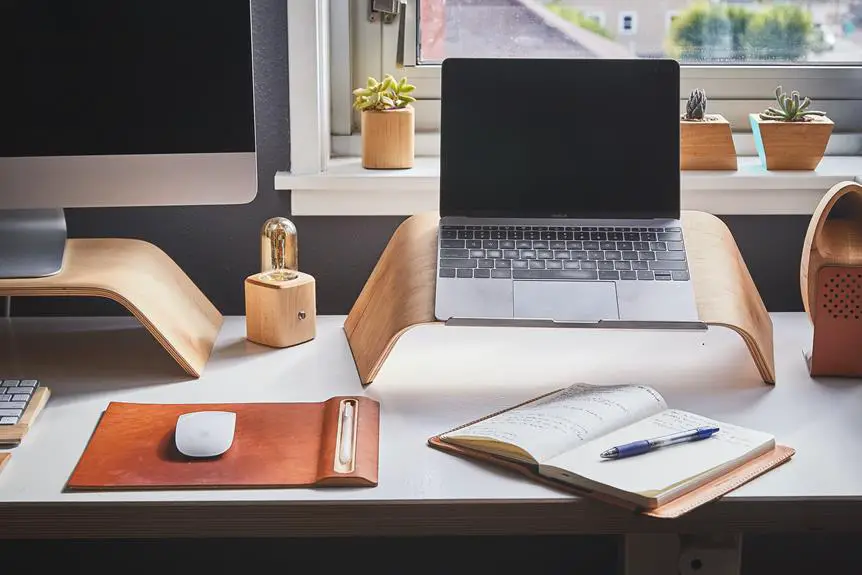As you settle into your home office, envision a workspace that supports your body and mind, allowing you to focus on your tasks without discomfort or strain. The way you arrange your surroundings can significantly impact your well-being and productivity throughout the day.
From the placement of your desk to the type of chair you sit in, every choice you make plays a role in maintaining ergonomics. Whether you're new to working from home or seeking to enhance your current setup, there are practical steps you can take to create a healthy and efficient workspace.
Key Takeaways
- Choose a comfortable and well-designed workspace, including a comfortable chair and proper lighting.
- Invest in ergonomic furniture, such as an adjustable chair and desk, to support your posture and reduce strain.
- Position your monitor and keyboard correctly to avoid eye strain and maintain a comfortable typing position.
- Incorporate movement and stretching into your work routine to prevent stiffness and maintain overall well-being.
Setting Up Your Workspace
To create an ergonomic home office, start by selecting a comfortable chair and positioning it at a height that allows your feet to rest flat on the floor. Lighting considerations are crucial. Position your desk so that natural light falls on your workspace, reducing eye strain. However, add a desk lamp with adjustable brightness for cloudy days or late-night work. When organizing supplies, keep frequently used items within arm's reach to minimize unnecessary stretching or reaching. This minimizes the risk of strain.
Noise reduction is key to creating a calming environment. Consider using noise-canceling headphones or a white noise machine to minimize distractions. Additionally, adding a few indoor plants not only enhances the aesthetics but also helps in reducing stress and creating a tranquil atmosphere.
To maintain an ergonomic workspace, ensure that your computer screen is at eye level to reduce strain on your neck. Also, invest in an ergonomic keyboard and mouse to prevent wrist and hand discomfort. Keep your phone, notebook, and other frequently used tools nearby to avoid unnecessary reaching or twisting.
Choosing the Right Furniture
Select furniture that provides proper support and comfort for long hours of work in your home office. When choosing the right furniture, consider the following:
- Ergonomic Chair: Invest in an ergonomic chair that supports the natural curve of your spine and promotes good posture. Look for a chair with adjustable seat height, lumbar support, and armrests. Ensure that the chair allows you to sit with your feet flat on the floor and thighs parallel to the ground. This will help reduce the risk of back strain and discomfort during prolonged sitting.
- Adjustable Desk: Opt for an adjustable desk that allows you to alternate between sitting and standing while working. This can help alleviate the negative effects of prolonged sitting, such as musculoskeletal issues and reduced circulation. An adjustable desk enables you to customize the height according to your comfort and ergonomic needs, promoting better blood flow and reducing strain on your back and neck.
- Proper Lighting: Consider the lighting in your home office. Ensure that your workspace is well-lit to reduce eye strain and fatigue. Position your desk near natural light sources, if possible, and incorporate task lighting to illuminate your work area effectively. Good lighting can contribute to a comfortable and productive work environment.
Optimizing Monitor and Keyboard Placement
Position your monitor and keyboard to promote a neutral posture and reduce strain on your body while working in your home office.
Start by adjusting the monitor height so that the top of the screen is at or slightly below eye level. This helps prevent neck strain and encourages a more natural head position. Your eyes should look slightly downward when viewing the middle of the screen. Place the monitor about an arm's length away from you to reduce eye strain.
Next, adjust the keyboard angle to promote a comfortable wrist position. Keep your keyboard at a negative tilt, meaning the front of the keyboard is slightly higher than the back. This helps keep your wrists in a more natural and ergonomic position, reducing the risk of wrist discomfort or injury. Your elbows should be at a 90-degree angle when typing, with your forearms parallel to the ground.
This setup allows for a more relaxed and comfortable posture while typing.
Prioritizing Comfort in Seating
For a comfortable home office setup, ensure that your seating provides proper support and promotes good posture. When it comes to prioritizing comfort in seating, there are several options to consider for achieving an ergonomic and supportive work environment.
Ergonomic Chair Options
Invest in an ergonomic chair that's adjustable and provides adequate lumbar support. Look for chairs with adjustable armrests and seat height to customize it according to your body's needs. A chair with a reclining feature can also help reduce pressure on your spine and provide added comfort during long hours of work.
Lumbar Support Cushions
Consider using a lumbar support cushion if your chair doesn't provide sufficient lower back support. These cushions are designed to maintain the natural curve of your spine, reducing strain on the lower back muscles and promoting better posture. They can be easily attached to your chair and are especially beneficial if you spend extended periods sitting down.
Seat Cushions
Seat cushions can also enhance comfort by providing additional padding and promoting better blood circulation. Look for cushions that are made of supportive and breathable material to prevent discomfort from extended periods of sitting.
Incorporating Movement and Stretching
Consider incorporating regular movement and stretching into your work routine to prevent stiffness and improve circulation while working in your home office. Taking active breaks throughout the day can help alleviate muscle tension and reduce the risk of developing musculoskeletal issues. Desk exercises, such as shoulder rolls, neck stretches, and seated leg lifts, can be seamlessly integrated into your work schedule, promoting flexibility and mobility.
In addition to incorporating active breaks, engaging in flexibility and mobility exercises can further enhance your physical well-being while working from home. Simple movements like standing up and stretching, reaching for the ceiling, and touching your toes can help combat the sedentary nature of office work. You can also consider incorporating yoga or Pilates routines during your breaks to improve posture and relieve muscle tightness.
It's important to be mindful of your body's need for movement and actively seek opportunities to stretch and re-energize throughout the day. These intentional movements not only benefit your physical health but can also enhance your mental clarity and productivity. By integrating movement and stretching into your home office routine, you can foster a more balanced and sustainable approach to working, promoting both physical and mental well-being.
Frequently Asked Questions
How Can I Create a Designated Work Area in a Small Living Space?
So, you want to carve out a workspace in a tiny living area? Try creating visual boundaries with room dividers or bookshelves. Make the most of vertical space with wall-mounted desks and storage.
What Are Some Tips for Organizing and Managing Cables and Cords in a Home Office Setup?
You can improve cable management and desk organization by using cable clips or zip ties to group cords, label them for easy identification, and invest in a cable organizer to keep everything tidy and accessible.
Are There Any Recommended Lighting Solutions for Reducing Eye Strain and Fatigue in a Home Office?
When reducing eye strain and fatigue in your home office, opt for natural lighting whenever possible. If needed, adjustable desk lamps can help supplement natural light, providing a customizable and comfortable work environment.
How Can I Maintain Good Posture and Ergonomics While Working on a Laptop or Tablet?
To maintain good posture and ergonomics while working on a laptop or tablet, use laptop accessories to elevate the screen and an external keyboard and mouse. For tablets, use a tablet stand to adjust height and angle for proper posture.
What Are Some Effective Ways to Incorporate Ergonomic Principles Into a Standing Desk Setup at Home?
Imagine the benefits of a standing desk: improved posture, increased energy, and reduced back pain. Elevate your setup with ergonomic desk accessories like a monitor stand, anti-fatigue mat, and adjustable keyboard tray for optimal comfort.



